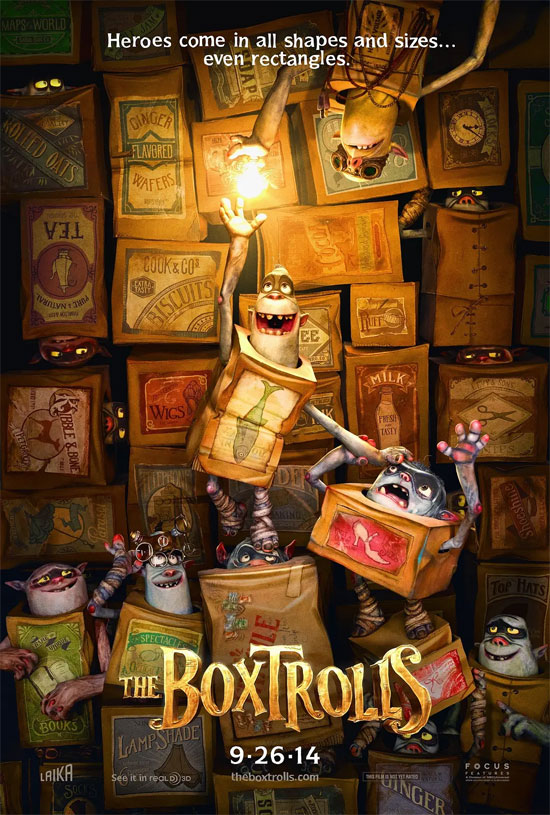Film Name: 盒子怪 / The Boxtrolls

This isn’t the first story depicting the beautiful hearts of ugly protagonists—Shrek stands as a classic in this vein. Nor is it the first tale of other species adopting human infants; Princess Mononoke’s story is already deeply ingrained in our collective memory. It’s not the first film to tackle racial misunderstandings, war, and reconciliation—last year’s smash hit Ernest & Celestine delivered such an impact, to name just one recent example. As for themes like the value of fatherhood and satire on social hierarchies, they’re practically clichés…
Yet, blending so many emotions together, “The Boxtrolls” might just be the first of its kind. That’s precisely why the film feels so richly satisfying. Moreover, it introduces the innovative and intriguing prop of “boxes,” which not only imbues the characters with vivid imagination and animation-like qualities but also aptly symbolizes the enclosed space where every timid soul longs to hide.
It must be acknowledged that the film maintains Laika’s signature somber aesthetic in lighting, with most scenes unfolding under the cover of night. This creates a subtle psychological weight that may deter some younger viewers. Yet equally undeniable is the film’s profound resonance for adults—it offers substantial food for thought, transcending the typical family-friendly entertainment mold.
From a societal perspective, the Cheese Town residents’ prejudices against the Box Creature undoubtedly stem from the town’s sole mass medium—an ambitious individual’s street propaganda. Much like how our perceptions of other nations, and theirs of us, are often shaped by their respective media narratives, this propaganda proves adept at distorting reality and clouding people’s judgment. More intriguingly, this opportunist even staged the rumor-mongering as an open-air spectacle, prompting reflection on the true nature of so-called artistic works. Ultimately, a passionate, feisty, and righteous little girl, alongside a human boy adopted by an alien race—ignorant yet wise—become the keys to shattering this blindness. Fear invariably makes people prone to believing sensationalist claims, a tendency easily exploited by the ambitious.
From a human perspective, the little girl’s father left a profound impression on me. Selfish and indifferent, he valued the white hat—a symbol of status—above all else. When the boy publicly revealed his origins, the father’s sole concern was the cost of retrieving the cheese that had fallen into the sea due to the boy’s mistake. On one hand, his coldness seems laughably extreme; on the other, it sends a chill down your spine. Isn’t life full of such people? Have we not all played such roles at times? The film’s satire feels like a comic strip’s sharp critique of society. The aristocrats’ lavish exteriors and cold hearts contrast starkly with the warm-hearted Box People living in the depths—a contrast that truly leaves one sighing. No wonder the boy emerging from there felt ashamed to be called a “human boy.”
The film is rich with details worth savoring. For instance, when the giant cheese rolls down the stairs, the aristocratic butler opens the door as if nothing happened. What a rigid, robotic butler! Had he used a shred of common sense, the cheese wouldn’t have tumbled into the sea. Yet this very rigidity satirizes the upper class’s elaborate formalities.
Laika Studios has pushed stop-motion animation to an extreme level of perfection—so close to CG animation that it’s hard to detect the telltale signs of frame-by-frame work in the characters’ expressions and pacing. When the little boy and girl first meet in the pitch-black night, their squinted gazes and subtly downturned mouths make it almost unbelievable that this is a stop-motion film. From a stop-motion perspective, this is a masterpiece, yet it also loses some of its essence by resembling CG too closely.
I genuinely hoped the film would explore the emotional bond between the boy and his box-monster father, Fish, more deeply. Especially after learning his true identity, his psychological turmoil should have been more pronounced. This would have made the dramatic reversal in their relationship—forged by genuine affection—all the more moving. The current film gives the impression that finding his human father allows him to downplay his relationship with Fish. While blood ties and affection aren’t mutually exclusive in the story, one must be emphasized over the other.
Unlike previous Laika films, The Boxtrolls is brimming with irresistibly funny humor. This shines most brilliantly in the scene where the boy, raised by box trolls, enters high society and makes a series of hilarious blunders. I’d even argue that scene is the film’s absolute highlight. Through the boy’s expressions and actions, it reflects the full spectrum of human warmth and coldness.
The ultimate dismantling of the ambitious rumor-monger’s scheme comes through communication—through the breaking down of information barriers. The once-fearsome, man-eating monsters turn out to be such adorable, lively, and warm-hearted little creatures. The truth, it turns out, is never far from us.
Please specify:Anime Phone Cases » The Boxtrolls 2014 Animation Film Review: Rumors and Truth